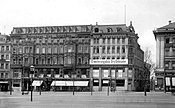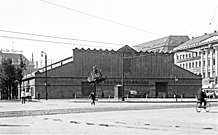Wilhelm-Leuschner-Platz (Leipzig)
| Wilhelm-Leuschner-Platz | |
|---|---|
| Place in Leipzig | |
 Western part of the square (formerly Königsplatz) |
|
| Basic data | |
| place | Leipzig |
| District | Center-South |
| Created | 1749 |
| Hist. Names | Koenigsplatz |
| Confluent streets |
Petersstrasse , Roßplatz , Windmühlenstrasse, Peterssteinweg , Dimitroffstrasse, Martin-Luther-Ring |
| Buildings |
Old Grassi Museum , bowling club, S-Bahn station |
| use | |
| User groups | Car traffic (including parking), public transport , cyclists , pedestrians |
| Space design | in planning |
| Technical specifications | |
| Square area | approx. 6 ha |
The Wilhelm-Leuschner-Platz is a place south of Leipzig city center. It is named after the German trade unionist and social democratic politician Wilhelm Leuschner (1890–1944), who fought against National Socialism . Before that, part of it was called Königsplatz since 1839 . The square is essentially undeveloped and has been waiting to be designed since the end of the Second World War .
Location and limitation
Wilhelm-Leuschner-Platz is located in the Zentrum-Süd district in the Mitte district . It forms the transition from the city to the inner southern suburb and is located on the southern section of the inner city ring . It takes up the area of the former Königsplatz, and on the eastern side there is the large fallow area around the former central market hall .
Starting from the north, the square is bounded by the following streets in a clockwise direction: Roßplatz , Grünewaldstraße, Windmühlenstraße and Peterssteinweg .
history
In the Schmalkaldic War in 1547 the southern suburb, which almost reached the moat, was burned down and this free field of fire ( glacis ) in front of the Peterstor was not built on later.
In 1778, the Leipzig architect Johann Carl Friedrich Dauthe (1746–1816) leveled the site and created a rectangular square surrounded by rows of trees. It was named Esplanade . A monument was erected in its center in 1780. It showed a statue of Elector Friedrich August III created by Adam Friedrich Oeser (1717–1799) . (1750–1827) on a plinth by Dauthe. Friedrich August became King of Saxony in 1806 as Friedrich August I. As a result, it was logical in 1839 to name the square, which was now built on three sides, after the now royal monument, Königsplatz.
At the end of the 19th century, some of the houses on Königsplatz were replaced by more representative buildings. From 1894 to 1897 Hugo Licht (1841–1923) built the (old) Grassimuseum (today the city library ) on the southern edge . The “Münchner Hof” hotel and, from 1896, the department store of the brothers Moritz (1872–1939) and Julius Ury (1873–1940) were built on the west side.
Until 1907, the Leipzig Small Fair was held on Königsplatz before it had to move to the Frankfurt Meadows. In 1921 the square was built over with a large, temporary textile exhibition hall, which only existed until 1932. In 1935 the Friedrich August monument was moved to the garden of the Gohliser Schlösschen . The reason was a planned redesign and enlargement of the square, but this did not materialize because of the war .
During the air raid on December 4, 1943 , the buildings on Königsplatz were destroyed, with the exception of the old Grassi Museum, which was badly damaged. The area adjacent to the east between Brüderstraße, Markthallenstraße and Kurprinzstraße (today Grünewaldstraße) was completely destroyed, except for the damaged central market hall. In the 1950s, the hall, which was partly in ruins but partly still functional, was viewed as an eyesore and was torn down in its entirety as part of the “ National Construction Work ”.
The entire free space with the empty street sections of the Brüderstraße and Markthallenstraße was de facto added to Königsplatz, which was renamed Wilhelm-Leuschner-Platz in 1945, and this is now viewed in the size described above. The place was partly used as a parking lot, partly trees and bushes grew.
In 1975 a pedestrian tunnel was built under the central tram stop from the north side of Wilhelm-Leuschner-Platz to the city center, which was abandoned when the city tunnel was later built. In 1985, the bowling club was also built on the north side of the square according to plans by Winfried Sziegoleit (* 1939) as the entrance building to 14 underground bowling lanes, other sports facilities and 310 restaurant spaces in a no longer used tram power substation. The facility closed in 1998. In 2020 it became known that the Natural History Museum Leipzig should move there. In the 1990s there was a two-story park pallet on the western part of the square, which was moved to the St. Georg Clinic in 2001 .
In 2011 the city council decided to erect the "Unity and Freedom Monument" in question since 2007 in memory of the Peaceful Revolution in 1989 on Wilhelm-Leuschner-Platz. Wilhelm-Leuschner-Platz was to be renamed “Platz der Friedlichen Revolution”. The result of the subsequent artistic competition for the monument was generally not convincing. On July 16, 2014, the city council ended the previous competition process and repealed the decision on the location.
In 2013 the city tunnel for the S-Bahn in Central Germany went into operation. The southern entrance to the Wilhelm-Leuschner-Platz station is isolated in the middle of the square. With the completion of the Provost Church of St. Trinity at the confluence of the Peterssteinweg in the Martin-Luther-Ring , the square on its western side received part of its visual delimitation.
With the end of the discussion about monuments in connection with Wilhelm-Leuschner-Platz, consideration of its development has started again. On December 16, 2015, the city council decided on guidelines for the “continuation of the establishment procedure for the development plan Wilhelm-Leuschner-Platz / East”. Accordingly, three assemblies are to be built on the east side of the square: the northern one with a high-rise building on the northeast corner (Roßplatz-Carré), the middle one with the new central market hall (market hall complex) and a southern one between Brüderstrasse and Windmühlenstrasse (Windmühlenbogen). There is disagreement about the western part. The city administration favors a large, undeveloped space for events. Various voices, including an architects' initiative, are striving for a fourth building complex and reducing the free space to the size of the old Königsplatz. In the process, Roßplatz-Carré and the market hall complex were to be "dovetailed" around a smaller inland square in order to revitalize the area.
literature
- Horst Riedel, Thomas Nabert (ed.): Stadtlexikon Leipzig from A to Z . 1st edition. Pro Leipzig, Leipzig 2005, ISBN 3-936508-03-8 , pp. 644-645 .
- Vera Danzer, Andreas Dix: Leipzig - A regional history inventory in the Leipzig area . Ed .: Haik Thomas Porada . 1st edition. Böhlau, Cologne Weimar Vienna 2015, ISBN 978-3-412-22299-4 , pp. 172-173 .
- Gina Klank, Gernoth Griebsch: Lexicon of Leipzig street names . Ed .: City Archives Leipzig. 1st edition. Verlag im Wissenschaftszentrum Leipzig, Leipzig 1995, ISBN 3-930433-09-5 , p. 222 .
Web links
- Wilhelm-Leuschner-Platz. In: Leipzig Lexicon. Retrieved September 14, 2016 .
Individual evidence
- ↑ King's Monument. In: Leipzig Lexicon. Retrieved May 2, 2020 .
- ^ The Ury department store - a modern department store in Leipzig. Retrieved September 16, 2016 .
- ^ Peter Schwarz: The millennial Leipzig . tape 3 . ProLeipzig, Leipzig 2015, ISBN 978-3-945027-13-4 , pp. 192/193 (map) .
- ↑ Former bowling club, new location for natural history museum
- ↑ Location decision 2011: Wilhelm-Leuschner-Platz. In: City website. Retrieved September 18, 2016 .
- ^ Renaming of Leuschner-Platz: positive response from the parliamentary groups in Leipzig. In: LVZ October 5, 2011. Retrieved September 18, 2016 .
- ↑ Leipzig Freedom and Unity Monument. In: City website. Retrieved September 18, 2016 .
- ^ Wilhelm-Leuschner-Platz. In: City website. Retrieved September 18, 2016 .
- ↑ This is how the Wilhelm-Leuschner-Platz in Leipzig should look in the future. In: LVZ December 16, 2015. Retrieved September 18, 2016 .
- ↑ A Leuschnerplatz that one likes to walk on . In: Leipziger Volkszeitung . September 14, 2016, p. 18 .
Coordinates: 51 ° 20 ′ 6 ″ N , 12 ° 22 ′ 33 ″ E








